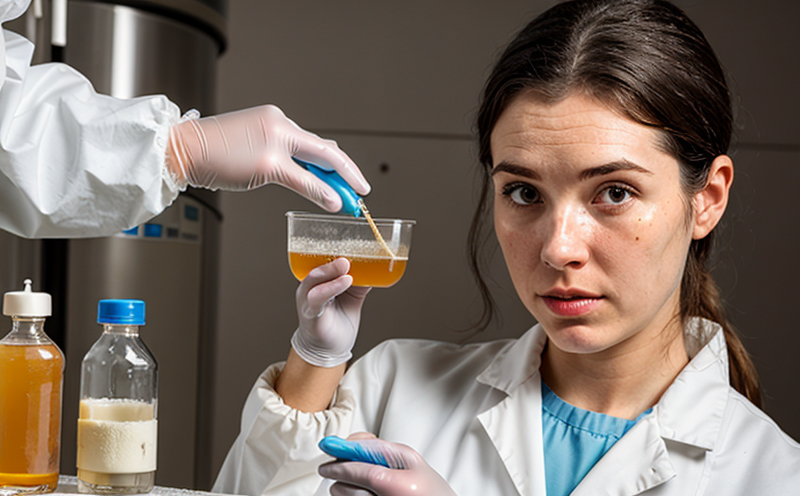AOAC 2006.06 Yeast and Mould Enumeration in Food and Beverages
The AOAC International method 2006.06 is a widely recognized standard for the enumeration of yeast and moulds in food, beverages, and other products. This test specifically targets yeasts (fungi classified as yeasts) and moulds (fungi not classified as yeasts), which can significantly impact product quality, safety, and shelf life.
The methodology is designed to detect and quantify these microorganisms by employing a series of biochemical assays. This approach ensures that the test accurately reflects the presence and abundance of yeast and mould species in a given sample. The technique is particularly valuable for industries such as food manufacturing, beverage production, and pharmaceuticals where contamination can lead to spoilage or health risks.
The AOAC 2006.06 method involves several steps, including sample preparation, inoculation onto selective media, incubation conditions, and colony counting. This process allows for precise enumeration of yeast and mould colonies in a standardized manner. The testing protocol is robust enough to differentiate between different species within the fungal kingdom, providing valuable insights into the microbial profile of the product.
The method's accuracy and reliability are enhanced by its alignment with international standards such as ISO 16237 for the enumeration of yeast and moulds in food products. This standardization ensures that laboratories worldwide can achieve consistent results when conducting these tests, facilitating global trade and quality assurance.
For industries like brewing, where yeast plays a crucial role in fermentation processes, this test is essential to ensure product safety and quality. In the pharmaceutical industry, ensuring the sterility of products is paramount, making AOAC 2006.06 an indispensable tool for maintaining high standards of cleanliness.
The testing process begins with proper sample collection and preservation to prevent contamination or loss of microbial viability. Once collected, samples are prepared according to the method's specifications. The inoculation onto selective media is critical in this step, as it helps differentiate between yeast and mould species while suppressing unwanted contaminants.
Incubation conditions play a vital role in the success of this test. Yeasts and moulds require different environments for optimal growth, which are carefully controlled to ensure accurate enumeration. After incubation, colonies are counted, and their characteristics are noted to identify specific species.
The results from AOAC 2006.06 provide valuable data on the microbial composition of food and beverage products. This information is crucial for quality managers in making informed decisions about product safety and shelf life. Compliance officers can use these test results to ensure adherence to regulatory standards, while R&D engineers can leverage this data to improve production processes.
Industry Applications
The AOAC 2006.06 method finds extensive applications across various industries where the presence of yeast and moulds is critical:
- Brewing Industry: Ensuring that the correct strains of yeast are used in fermentation processes.
- Dairy Products: Detecting spoilage-causing moulds to maintain product freshness.
- Cheese and Fermented Foods: Monitoring for contamination that can lead to off-flavors or textures.
- Bakery Industry: Controlling the presence of moulds in bread and pastries to extend shelf life.
The table below highlights specific applications across different sectors:
| Sector | Application |
|---|---|
| Brewing Industry | Ensuring proper fermentation and flavor development. |
| Dairy Products | Preventing spoilage by detecting moulds. |
| Cheese and Fermented Foods | Maintaining product integrity and flavor profiles. |
| Bakery Industry | Extending shelf life and ensuring food safety. |
The method is also applicable in the pharmaceutical sector, where maintaining sterility and purity of products is critical. It helps in monitoring the quality of raw materials used in manufacturing processes, ensuring that they meet stringent hygiene standards.
Quality and Reliability Assurance
- Precision: The AOAC 2006.06 method provides precise enumeration results, which are essential for accurate quality assurance.
- Consistency: Standardized procedures ensure consistent test results across different laboratories and batches of samples.
The testing protocol is designed to minimize errors and variability, ensuring that the results accurately reflect the microbial content in food and beverage products. This reliability is crucial for maintaining high standards of quality and safety.
In addition to precision and consistency, the method also ensures robustness against common challenges such as sample contamination or variations in growth conditions. This makes it a reliable tool for monitoring product quality over time.
The results from AOAC 2006.06 can be used to set benchmarks for microbial safety and quality control. Compliance officers can use these data points to ensure that their products meet regulatory standards, thereby safeguarding consumer health and maintaining brand reputation.
International Acceptance and Recognition
The AOAC 2006.06 method is widely recognized and accepted by international organizations and regulatory bodies. It aligns with global standards such as ISO 16237, which provides a framework for the enumeration of yeast and moulds in food products.
Compliance with this standard ensures that laboratories meet high-quality standards, facilitating trade between countries with different regulatory requirements. The method's international acceptance also makes it an excellent tool for companies operating globally.





